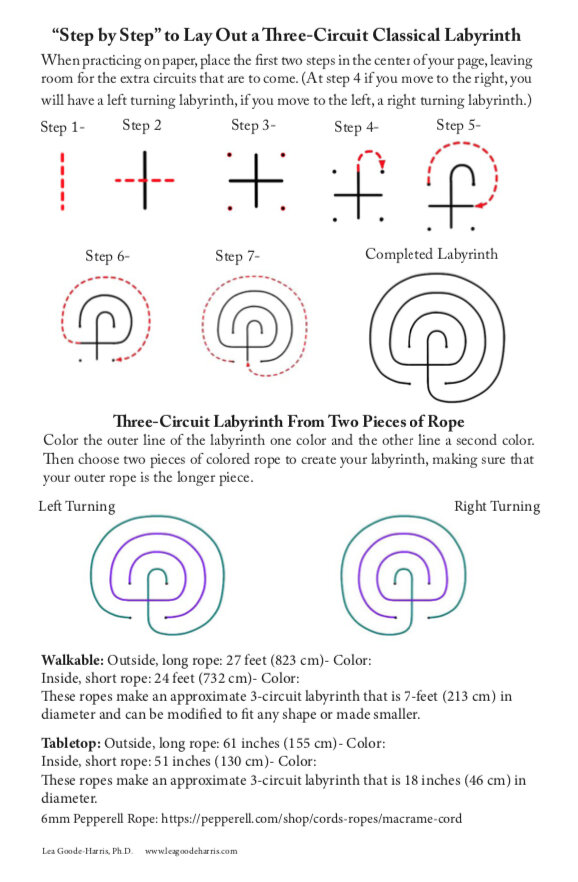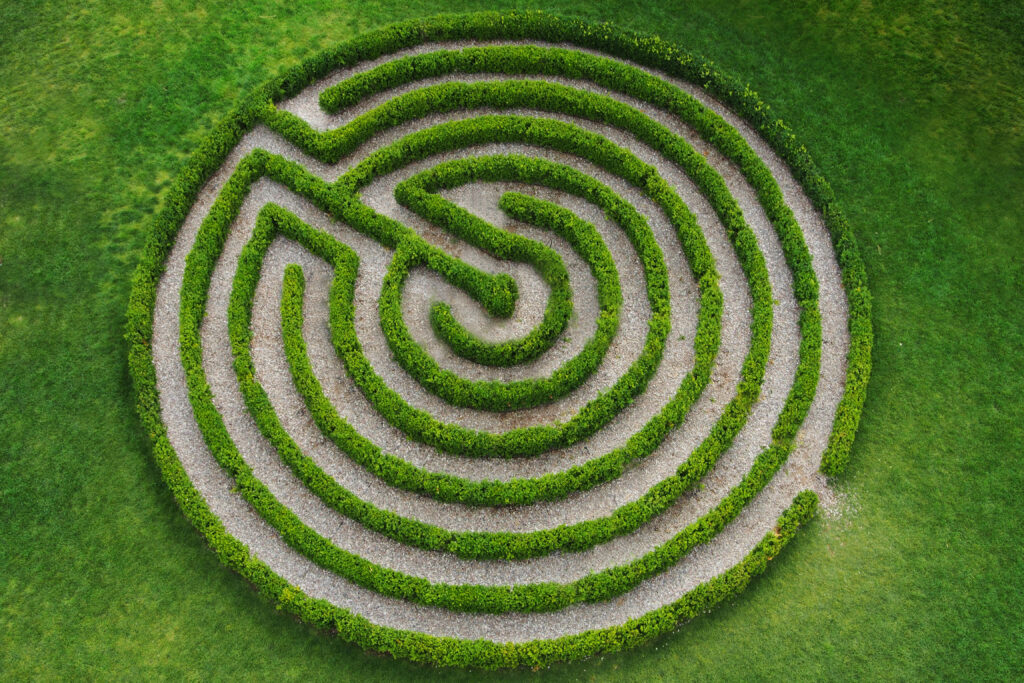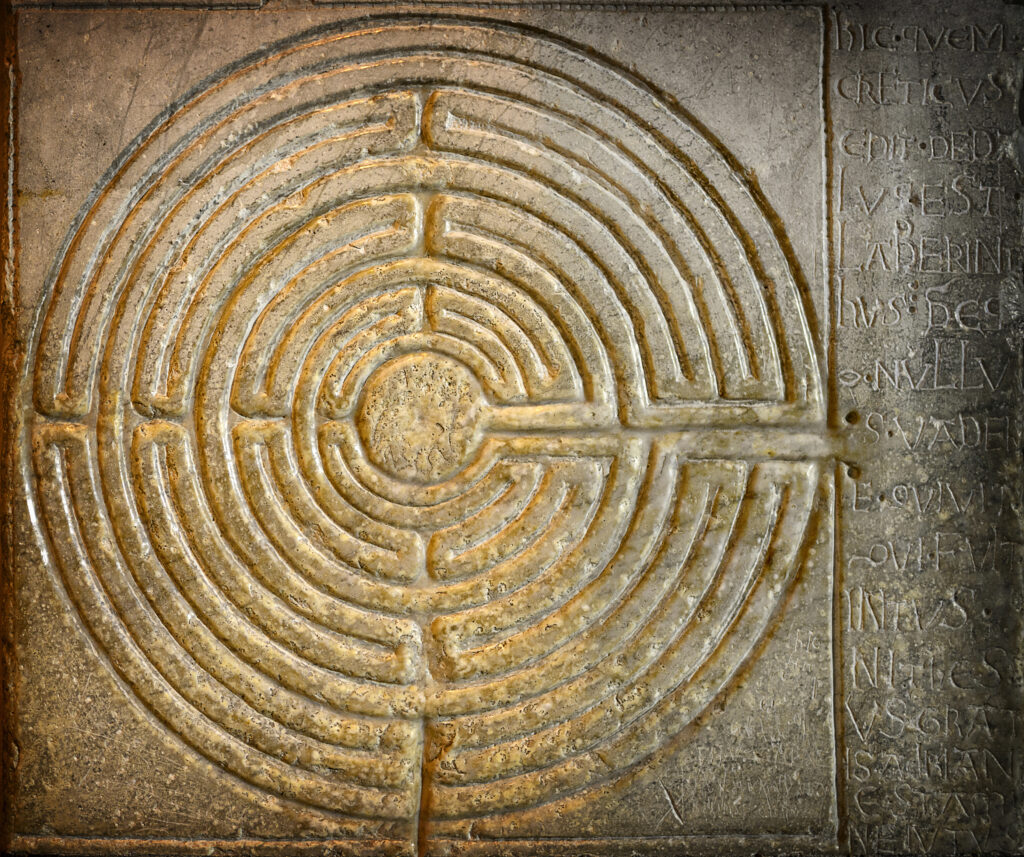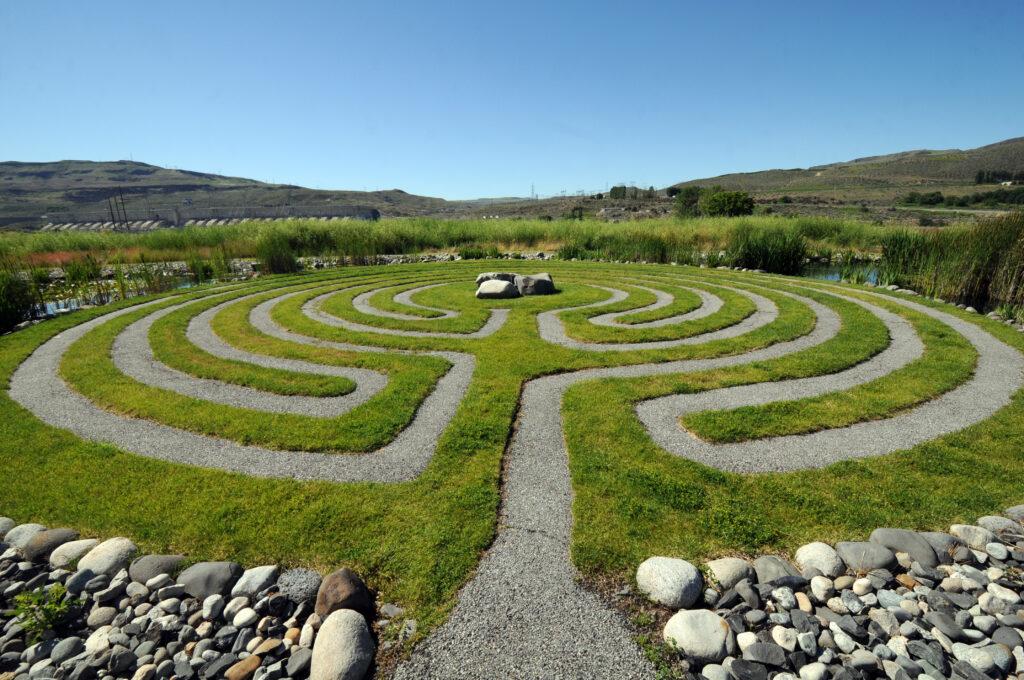Directions to Make a Labyrinth
Few things are more rewarding than to create a labyrinth and walk it afterwards. The love and care that go into the building – and in the walking – add to the transformative benefits of the labyrinth.
This part of the website will teach you how to make your own labyrinth. Currently, we have just directions for the Masking Tape Chartres Labyrinth. In the future, we will be adding Baltic, Classical, and Concentric labyrinth directions as well as tips for use of materials and other information to help you in your labyrinth-building efforts.
How to Make a Classical Labyrinth
Overview
For the Classical types, you begin with a seed pattern, the basic building block. The example here is a Classical Seven Circuit Labyrinth.
The Chartres-type is a bit more difficult to construct. Robert Ferrè tells us how to make one of these labyrinths with tape.
How to Make a Lea Goode-Harris 3-Circuit Heart of Placement Labyrinth
Click on the buttons below to download the JPEG or PDF of the construction of Lea’s Heart of Placement 3-Circuit labyrinth.

How to Make a Chartres Labyrinth
1. Making a Masking Tape Chartres Labyrinth
These instructions show you how to lay out a Chartres labyrinth with masking tape. For detailed instructions on creating a masking tape applicator, visit the Labyrinth Enterprises website. However, you can just as easily use stones or other materials. If you want to draw a Chartres labyrinth on canvas, you will need to know additional techniques which are available in our manual, Constructing a Chartres Labyrinth.
Masking tape labyrinths will be irregular and rustic in appearance, which is part of their charm. I think you will find when you are finished, you will be impressed by the work of art you have created. With a few volunteers, a flat surface and a generous supply of masking tape, it is possible to construct a labyrinth in under two hours. The best floor surface is cement. Vinyl or ceramic tile, terrazzo, or short-nap commercial-grade carpeting are also generally acceptable. Wooden floors are not usually suitable, as the tape can damage the finish.
Size is a consideration only with regards to the size of the space and the amount of tape. I use 60-yard rolls of three-inch-wide masking tape. For small labyrinths, two-inch-wide tape may be sufficient. A large labyrinth could use 15 to 20 rolls of tape, at a cost of five dollars each (total: $75-$100). Gaffers tape is probably more suitable, since it doesn’t leave any residue, but it is very expensive. Vinyl tapes have the advantage of being able to stretch, which is helpful when making circles. But when all is said and done, I have always used masking tape
The above photograph shows a 104-foot-wide masking tape labyrinth made for First Night St. Louis, on New Year’s Eve, 1998. We used 25 rolls of tape. I suggest buying plenty of tape, open them as you need them, and return what you don’t use. It is frustrating to run out of tape in the middle of making the labyrinth, leaving volunteers standing around idle.
Besides masking tape, you will need a measuring rope (or tape measure) that is three or four feet longer than the radius of your labyrinth and a ruler or yardstick. An old-fashioned plumber’s plunger is also helpful, for reasons that will shortly become apparent. The surface of the floor needs to be dry and clean or the tape won’t stick. You may wish to supply kneepads to your volunteers, as they will spend a lot of time crawling around the floor.
2. Determining the Measurements
Before beginning, you must determine the size of your labyrinth and make a guide rope that will be essential in laying out the pattern. There are 12 concentric circles in the labyrinth, enclosing 11 paths, or circuits. If you were to measure the labyrinth from edge to edge, directly through the center, you would first encounter 11 circuits, then the center, and then 11 circuits again on the other side. For calculating the diameter, then, you have the center plus 22 circuits.
The center is one-fourth the diameter of the entire labyrinth (not counting the lunations, which are the little circular shapes around the perimeter). The paths, therefore, occupy three-fourths of the diameter. Suppose, for example, that you are considering having the circuits three feet wide. First you multiply: 22 x 3 = 66. That represents the diameter of the paths, which comprises three-fourths of the diameter. To find the value of the center, the remaining one-fourth, you simply divide the three-fourths measurement by three, which gives you one-fourth. In this instance, three-fourths equals 66 feet, so dividing by three will yield the answer of 22 feet for the center. Thus, the diameter of a labyrinth with three-foot-wide paths equals 66 feet (the paths) plus 22 feet (the center) for a total of 88 feet. If you make lunations, add another four feet to the diameter, yielding 92 feet.
You can also calculate backwards. Suppose your space is 40 feet across, and you want to leave a little room around the edge of the labyrinth. Start with 36 feet as your intended diameter. Divide by four, finding that one-fourth equals nine feet. That will be the size of the center. The remaining 27 feet (36 feet minus 9 feet) will be the total width of the 22 circuits. By dividing, you find that one circuit equals approximately 14 3/4 inches. Adding the lunations, the total diameter comes out to approximately 38 ½ feet.
Once you know the path width and the diameter of the center, you are ready to make your measuring rope. Or, you could use a standard metal tape measure if you prefer. The tape measure isn’t likely to stretch, as the rope might. Whichever you use, we’ll just call it the guide. The guide will stretch from the center of the labyrinth to the perimeter, plus a few feet. On the guide you mark off the location of the 12 lines that form the labyrinth. In the case of the 36-foot labyrinth, remember that although the center is nine feet in diameter (all the way across) you are measuring the radius (starting at the center of the circle), which is half the diameter. Therefore, the measurement from the center to the first circle would be four and one-half feet. That’s 54 inches. If you are using a rope, make a loop at the end before making your marks. You will need the loop to attach to the center pole.
3. Making the Guide
The first mark will be equal to the radius of the circle. For our example, we are making a 36-foot circle with a nine foot center, the radius of which is 54. On rope, you can make a mark with a felt-tipped pen or magic marker. On a metal measuring tape (or on a rope) you can make the mark by wrapping a piece of tape at the designated point. (I like to number each one.) Then each additional path will be spaced according to the appropriate calculation that you made at the beginning. For our example, that is 14 and 3/4 inches apart. In such case, the second mark will be 54 inches plus 14 and 3/4 inches, or 68 and 3/4 inches. The third mark will be 68 and 3/4 inches plus 14 and 3/4 inches, and so forth, until all of the marks are completed.
The guide needs to be securely fastened to the center of the labyrinth. You could have someone hold a broomstick in the center, but they would get very bored and would likely move. I suggest a board with a nail in it, which you can tape to the floor so that it doesn’t move. The guide must have 360-degree movement. Since I make labyrinths frequently, I have constructed a round board with a one-inch hole in the middle. Over that hole I have placed a floor flange for a one-inch pipe (found in the plumbing department of any hardware store). Screw the flange to the piece of wood, over the hole. I mark the center of the labyrinth with an “X.” Looking through the hole in the board (through the flange) I line up the board on the center “X.” Then I screw a four-inch piece of pipe into the flang and place a 20-kilo (44-pound) barbell weight over the pipe, to keep the board from moving. The pipe is long enough so that it sticks up above the weight. I attach the guide to the pipe by making a loop in the rope or tying a loop to the end of the tape measure.
4. Making the Entry Paths
You will need to consult a drawing of the labyrinth so that you can remind yourself as to the location of the various components. Notice there are two straight entry paths, one to get into the labyrinth and the other leading into the center. The latter path is on the right, and is centered on the center axis of the labyrinth. By first laying down the three straight lines that form the two parallel entry paths, you will avoid making circles where they don’t need to be. Of course, if you make a mistake, with masking tape it’s easy to correct.
Stretch out the guide to mark the center axis of the entry path that leads into the center (the one on the right, as you look inward from the perimeter of the labyrinth). Measure outward from the guide a distance equal to one-half the path width. In our example, the path is 14 and 3/4 inches, so you measure outward 7 and 3/8 inches on either side of the guide. Mark these measurements in several places with pieces of tape. Lay out these two straight side lines with your wide masking tape. You can make straight lines by having two people stretch a long piece of tape just above the floor and then having a third person push it down onto the floor. (I hope you get it straighter than my drawing.)
After the first two lines are done, measure over one path width to the left and install the third straight line, thereby completing the layout of the entry paths. These lines will undergo a little modification later. For now, just extend them from the first circle out to the twelfth circle.
5. Getting Started
The guide needs to be securely fastened to the center of the labyrinth. One way is to put a toilet plunger in the center of the labyrinth, have someone stand on it (or tape it to the floor, or put a barbell weight over it) so that it can’t move. Attach the guide. If you sare using rope, then a loop will suffice. Be sure that you make your marks for the circles after tying the loop. If using a metal tape measure, saw off the handle of the plunger so it only sticks up an inch or so. Hammer a nail into the top of the handle and hook the tape measure on it. If there is no hole in the tape measure, wrap masking tape around the end of the tape measure so that it sticks out beyond the end, and put a hole in the masking tape. Or you could just have someone hold a broomstick. If that’s the case, you may still want to tape it down in some fashion or at least mark its spot on the floor, because volunteers have a way of losing concentration and inadvertently moving the broomstick or plunger, thereby throwing off the measurements. You may think up other ways to attach the rope. It must have free 360-degree movement. If using a tape measure, you may be able to put a board on the floor, hammer a nail at the desired center point, and slip the end of the tape measure over the nail.
Since I make labyrinths frequently, I have constructed a round board with a one-inch hole in the middle. Over that hole I have placed a floor flange, which is found in the plumbing department of any hardware store. It can be screwed down, and has threads that allow you to screw a pipe into it. Inside the pipe I have jammed a wooden dowel with a nail in the top. With this system, I mark the center of the labyrinth with an X, then place the flat wooden piece (it doesn’t have to be round) over the center-to-be of your labyrinth, looking through the hole in the flange to make sure it is centered on the X. If taping the board to the floor, this is the time to do it. In my case, I screw the pipe into the flange and then lower a 20-kilo barbell weight over the pipe, to hold it down without moving.
You can wait until the guide is attached to the center post to lay out the marks for the twelve concentric circles, measuring out from the center. The first mark will be equal to the radius of the circle. For our example, we are making a 36-foot circle with a nine foot center, the radius of which is 54. On rope, you can make a mark with a felt tipped pen or magic marker. On a metal measuring tape, you can make the mark directly on the guide by wrapping a piece of tape at the designated point. Then each additional path will be spaced according to the appropriate calculation that you made at the beginning. For our example, that is 14 and 3/4 inches apart. In such case, the second mark will be 54 inches plus 14 and 3/4 inches, or 68 and 3/4 inches. The third mark will be 68 and 3/4 inches plus 14 and 3/4 inches, and so forth, until all of the marks are completed.
6. Laying Out the Circles
Use the guide to lay out the circles. Pull it straight, and then release it so that it lies freely on the floor, without being under pressure. Begin at the entrance lines, and move around the labyrinth. Each time you lay down the measuring rope on the floor, have volunteers put a little piece of tape onto the floor next to each line measurement on the rope. (Small white peelable dots from an office supply store work well for markers. Or just tear off a small piece of masking tape to use.) Then move the rope a few feet, and repeat this process. Work your way all the way around the labyrinth.
7. Connecting the Dots
Next, make concentric circles by laying down the three-inch masking tape directly over all of the little tape markers. If you have long continuous pieces of tape, it will be easier to pull up when it comes time to remove the labyrinth again. Since you are making a curved line, the tape doesn’t lie flat. Through practice you will develop some ways of tucking it or turning it.
Here’s how I do the tape. I sit on the inside (towards the center) and work in a clockwise direction. As I make an arc with the tape, one edge of the tape will be fully stretched (the outside of the line, which is the edge further away from me). The other edge (closest to me) will be slightly shorter. I pull the tape to its full distance on the outside edge, pulling it to my right. Holding it in place, I brush the inside edge back towards the left. This causes it to make a little tuck in the tape.
8. Making the Turns
To convert a group of concentric circles into a labyrinth you must install the turns. The locations for these are shown in the image below. Traditionally, these back-to-back turns are shaped like bow ties, also called labryses. (A labrys is a double-headed ax in Minoan mythology.) You can just use a straight line, or you can get fancier and make them rounded. If you want to really make it fancy, use a razor or knife to trim the tape into a smooth circular shape.
To make a turn from one circuit to another you must remove a piece of tape from the line that separates the two paths involved. Here’s a secret on how to locate the turns easily. Note that at the top of the labyrinth there are four turns. Look at the bottom one, it is centered on circle 2, which is the circle from which you will remove a bit of the tape to open the turn. Now, move your eyes clockwise to the innermost labrys on the right side of the labyrinth. It is centered on circle 3. Continue clockwise past the entrance and to theinnermost labrys on the left side, which is centered on circle 4. Do you see the pattern? The labryses extend outward in ascending numerical order in a clockwise spiral. The next one at the top is circle 5, the right is circle 6, the left circle 7 and so forth until circle 11, which is the outermost labrys at the top.
The entrance paths are flanked by single (rather than back-to-back) turns. The easiest way to figure them out is just to have your picture of the labyrinth handy to consult. The turns are grouped in pairs. Note that two circles (6 and 7, counting outward from the center) actually cross the entrance paths, creating turns into the labyrinth. The illustration to the right shows all of the turns in place. Now you have a labyrinth. If time is short, you have no more masking tape, or you just don’t want to do any more work, you can stop here. You have made a labyrinth. You don’t have to continue through the following steps. But you can if you wish.
For example, you can make rounded labryses by taping in a whole space and using a knife to trim it (see photo ).
9. Making the Petals
The center of the labyrinth has six flower petals. Where the petals meet, the merged lines are decorated with a little cross-like pattern. The tip of these petal crosses are exactly half way between the first circle and the center point of the labyrinth. For example, in the 36-foot labyrinth, the center is nine feet, which means the radius, from the center to the first circle, is four and one-half feet, or 54 inches. The tip of the petal cross is midway on the radius, or 27 inches from both the center and the inner circle (see below).
The straight lines on either side of the entrance path have one-armed crosses so that nothing sticks out into the path. These can be located easily. Opposite the entrance, at the “top” of the labyrinth, the petal cross is on the center axis of the labyrinth. This also can be easily located and put into place.
There remain two petal crosses on each side of the center. By eye or by measurement, locate the tips of these crosses on the midpoint of their respective radii, spaced evenly between the top cross and the entrance crosses. Once you have these laid out, then you have an easy job of making the petal circles, since you have marked both ends of the circle.
The tendency is to make the petals too pointed. Make them as rounded as possible. The petals will add an enormous amount of appeal to the labyrinth. People love to sit in the middle of the petals and meditate after reaching the center of the labyrinth.
10. Adding the Lunations
The circles forming the halo around the outside of the labyrinth are sometimes called lunations because they are believed to comprise a lunar calendar. With such a calendar, one can determine the date for Easter (the first Sunday after the first full moon after the spring equinox).
When making a labyrinth, the lunations take as much time as the rest of the labyrinth combined. Such small circles are almost impossible to make with tape. However, if you are energetic, you can make little lines that look like rays coming out of the labyrinth. The distance between the rays may be calculated by dividing the diameter of the labyrinth by 36. So, in our 36-foot example, the rays are placed every foot. Alternatively, you can calculate the circumference of the labyrinth and divide by 114. The circumference equals the diameter times pi (3.1416). So here’s the calculation for our example: 36 x 3.1416 = slightly more than 113. Divided by 114 it equals 11 and 29/32 inches). You don’t actually have 114 rays. One was removed for the entrance, leaving 113. The top-most ray lies right on the central axis.
The length of the rays is the same as the distance apart, which in this case is 12 inches. However, that includes the thickness of the line. So, if you are using three-inch tape, the rays are actually 12 minus 3, or nine inches. Cut a piece of cardboard three inches wide and twelve inches long, with a line across it at nine inches from the end. This will be your guide. Cut the tape so it is even on the end and a bit longer than nine inches (so it can lap onto the outer circle). Use the 12-inch piece of cardboard to mark the space between the rays. Then, turn it so that the line is at the edge of the circle and the cardboard sticks out nine inches. Slide it over so that it is beside the mark you made to locate the ray. This will show you where to put down the piece of tape you cut so that it is the right length. Just lay it right beside the cardboard.
The distance from the labyrinth entrance to the first ray on either side of the entrance is equal to one-half the distance between the rays. If the rays are one foot apart, the first rays would be six inches on either side of the entrance.
11. Tape Removal
Before you remove the tape, take a photo of your labyrinth. While you’re at it, send me a copy. Be sure to provide for volunteers to help you remove the tape, which will take almost as long pull up as it took to install it. A putty knife is helpful for getting under the edges.
You have already seen several photos from large masking tape labyrinths that we have made for New Year’s Eve. The photo below is a time exposure at a time when there were about 200 people in the labyrinth.
12. What About the Pillars?
The beauty of using masking tape is that the labyrinth can be altered to go around obstructions, such as pillars. If there are pillars in the space where you are installing the labyrinth, you can do several things. One is to put a pillar in the center of the labyrinth and size your labyrinth to fit within the next row of pillars. A second possibility is to incorporate the pillars within the labyrinth.
If there is a pillar in the center, there will be no place to attach the measuring guide. Here’s a solution. Measure the dimensions of the pillar and draw them on a piece of posterboard. Then use a compass to draw a circle that goes around the shape of the pillar, just touching the corners. Cut out the segments bordered by the circle and the pillar (shaded area in illustration to the right) and tape them on the floor next to the pillar, forming a circle. Proceed as before, this time having someone hold the guide to the edge of the circle, moving it slightly each time you reposition the rope (rather than having a center post). The person at the other end of the measuring rope can place the rope so it lines up with the center of the pillar. This will be accurate enough to get a usable result.
For pillars towards the outer edge of the labyrinth, just route the circuits around them as necessary. With tape, anything is possible.
Finally, if there is time left, you might want to trim some of the turns. I tape a razor knife to the end of a yardstick and swing it in a circle like a big compass. The end result gives a very finished appearance to what otherwise may be a rather rustic labyrinth. Likewise, if you have so many volunteers that you don’t know what to do with them, you could make all of the lunations circular rather than rays. (I’m crazy about labyrinths, but I’ve never been THAT crazy.)
Voila, you now have a Chartres-pattern masking tape labyrinth. Or, you could do this out doors with rocks. The technique is the same, putting rocks around in circles and then filling in between them later.
We would like to thank Robert Ferré for allowing us to use these pages on the Chartres type labyrinth. They come from his excellent website Labyrinth Enterprises.






